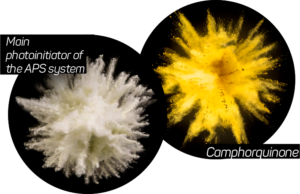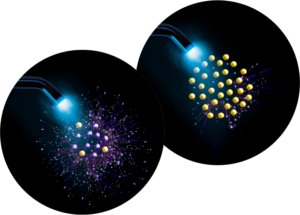The name itself suggests: Advanced Polymerization System (APS), a system that offers great advances for the polymerization of dental materials.
Author: Rayane A. Prochnow.
Esthetics
Smile esthetics has become a major concern among patients, professionals and the industry. Before the introduction of the APS technology, that concern was restricted to the composition of the polymeric matrix, of the pigments and the load of the dental materials. The photoinitiating system, usually with a basis of Camphorquinone in its formula, did not receive much attention (in spite of its intense yellowish hue) as there were no viable alternatives to replace it.


The impact of the yellowish hue resulting from the presence of Camphorquinone in light-curing materials has always been considered, but that problem was compensated in some way by the composition of such materials or simply absorbed. That way, most dental composites with high esthetic demand have systems that compensate the yellow hue. Adhesives, however, were highly colored and did not compensate that yellow hue.
With the development of the APS technology we have a new scenario, with the reduction of the impact of color in the performance of polymerization. Camphorquinone concentrations were reduced (being necessary only for starting the photopolymerization process) and is now combined with other photoinitiators and process propagators interacting among themselves and boosting the formation of polymers. That composition, called APS technology, has very low coloring and, therefore, does not significantly impact on the color of the composites that receive it, allowing for a more accurate predictability of the final color result and, consequently, improving esthetics.
Curing depth
The APS system increased the degree of photopolymerization of dental materials. It is a technology that shows excellent results in conversion degrees of monomers into polymers, with performances superior to camphorquinone-based systems, and can be adjusted to promote the curing of the material also in thicker layers. That advantage is noted especially in “bulk fill” single-increment composites (Opus Bulk Fill APS, Opus Bulk Fill Flow APS), because it guarantees that, in large increments, polymerization will happen in an efficient way, even in the back walls of the preparation, providing stability and durability to those restorations.


Longer working time
Besides the advantages that contribute to the polymerization efficiency and esthetics of the products, the APS advanced polymerization system also has an important advantage for product usability: significant increase in working time under reflector’s light (LED or halogen), photophores (magnifying glasses) or ambient light. In general, working times have proven to be 4 times longer than those commonly observed with traditional materials, and can reach up to 10 times, all without requiring the use of special lightcuring devices. The APS technology works perfectly with curing devices commonly used in the office, such as the traditional monowave and polywave.


APS in FGM products
The APS technology is present in several products, bringing distinct advantages to each of them. Adhesives, for example, become more esthetic (colorless), both in universal version (Ambar Universal APS) as well as in 5th generation versions (Ambar APS), which now offer enough translucency for the application in thin ceramic pieces, without modifying their color transmission and opalescence.
Also, it is worth pointing out the gain in polymerization performance, especially in moist environments, the most challenging condition. In the area of cements, in Allcem Veneer APS, used for cementing veneers and thin ceramic fragments, the APS technology with its superior esthetics allowed for the formulation of a product that is more stable in relation to color before and after polymerization, allowing for a more predictable result. In terms of usability, there were gains in working time, which make the cementation of those elements less sensitive, since the professional is able to adequately position the piece without worrying about the premature set of the cement.
In the composite Vittra APS, a premium composite formulated with submicrometric spherical loads of zirconia silicate and a BPA-free polymeric matrix, the action of the APS technology is complete. The technology boosts the high esthetic performance of the composite, providing more shade predictability, high conversion degree, and excellent mechanical properties, besides great working time, even under the reflector’s and dental loupe’s light. All this technology adds value and practicality to clinical procedures, thus providing dentists with advantages that go beyond esthetics.























